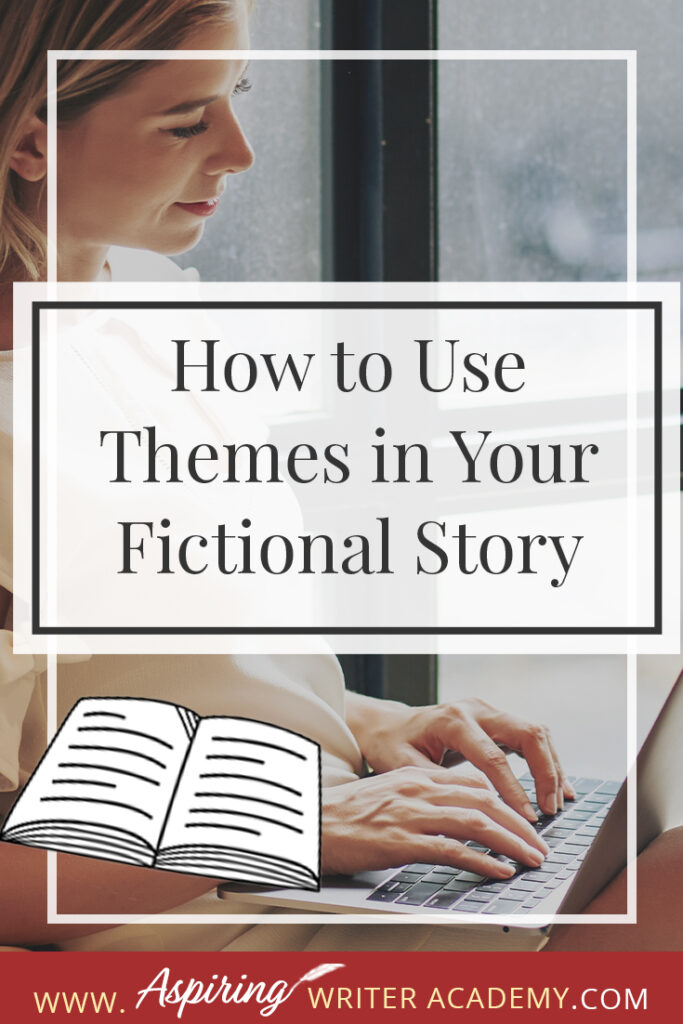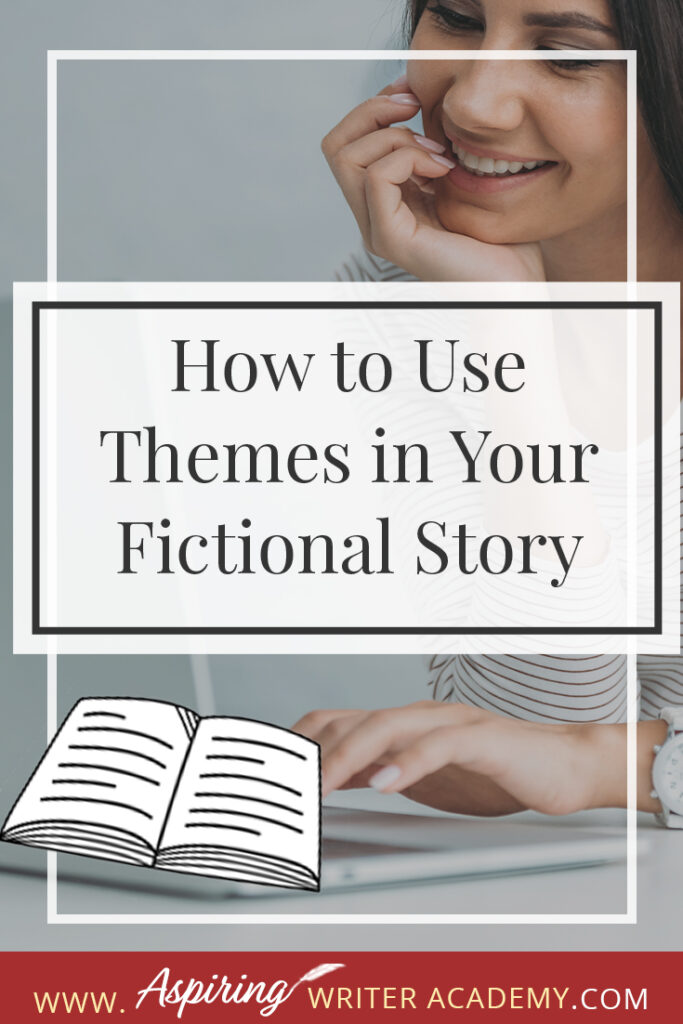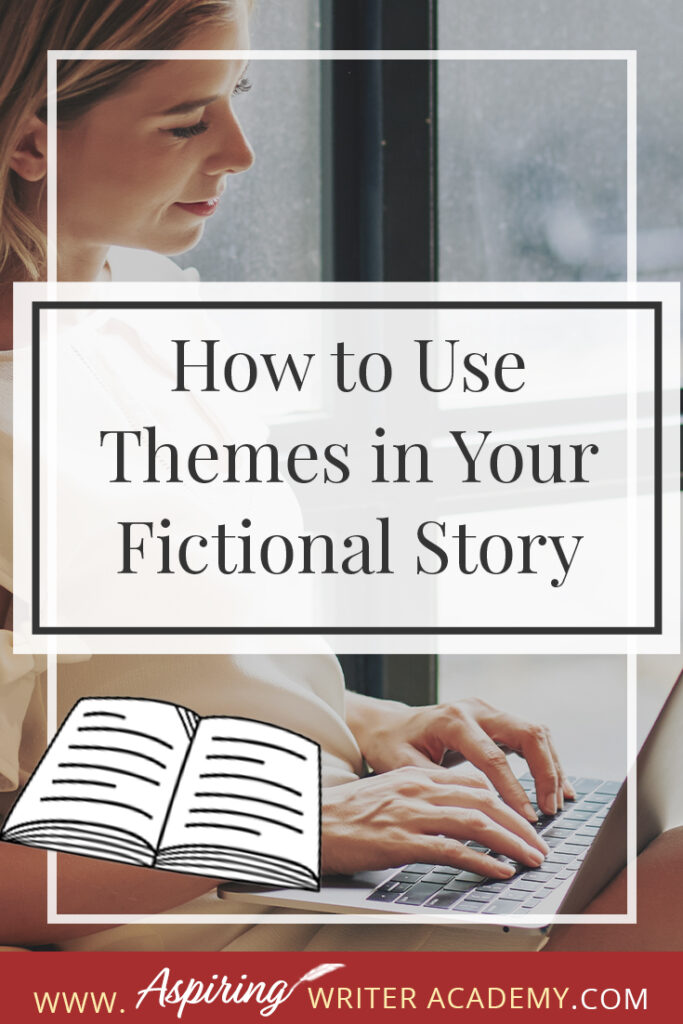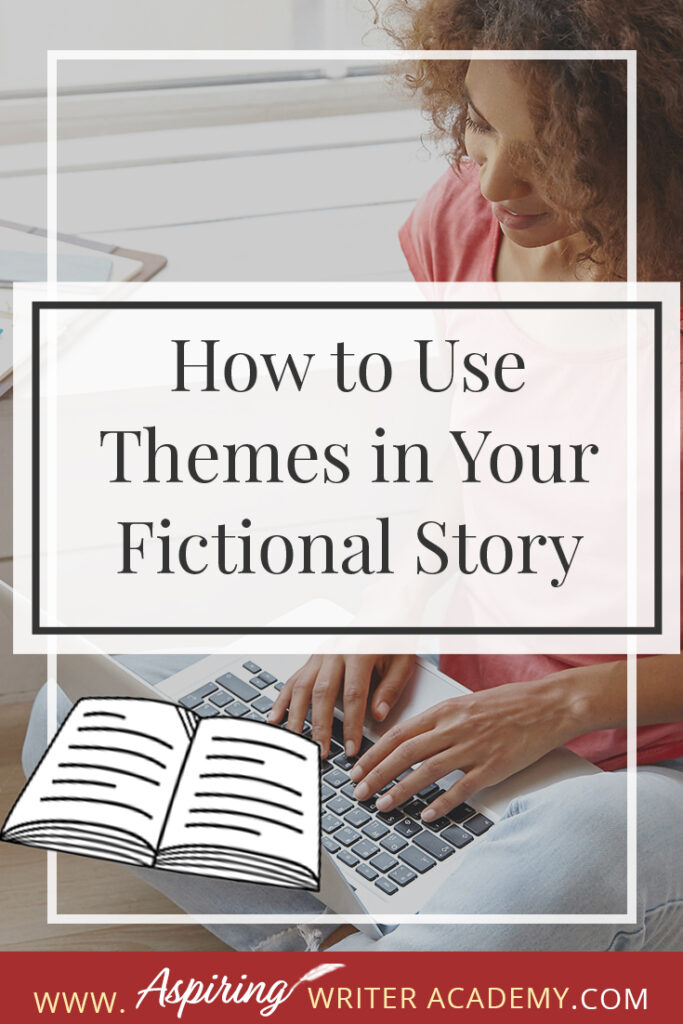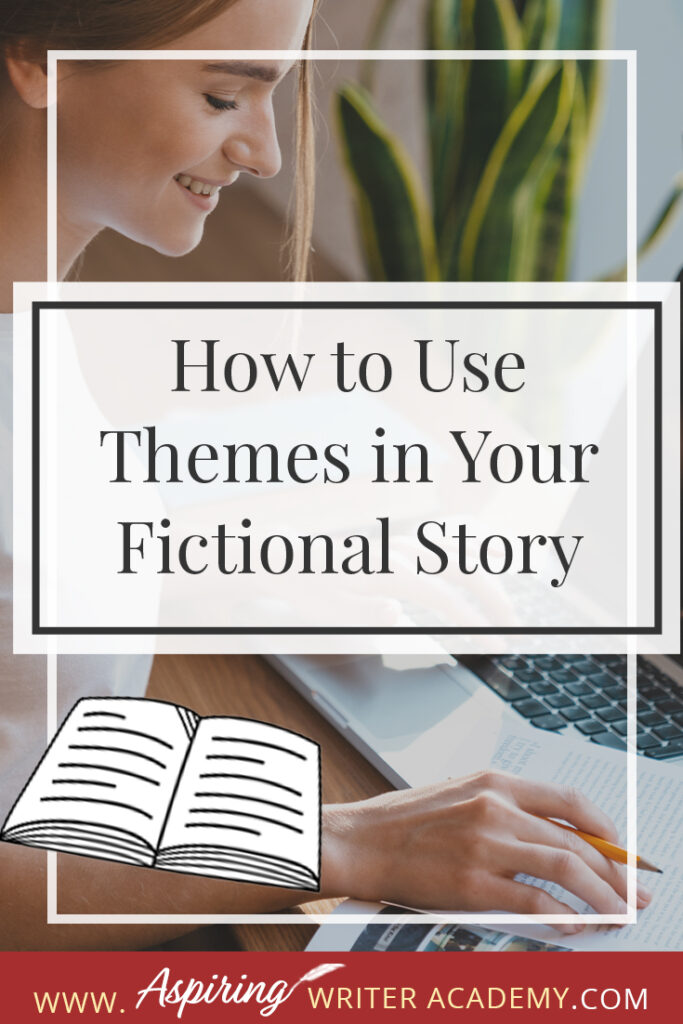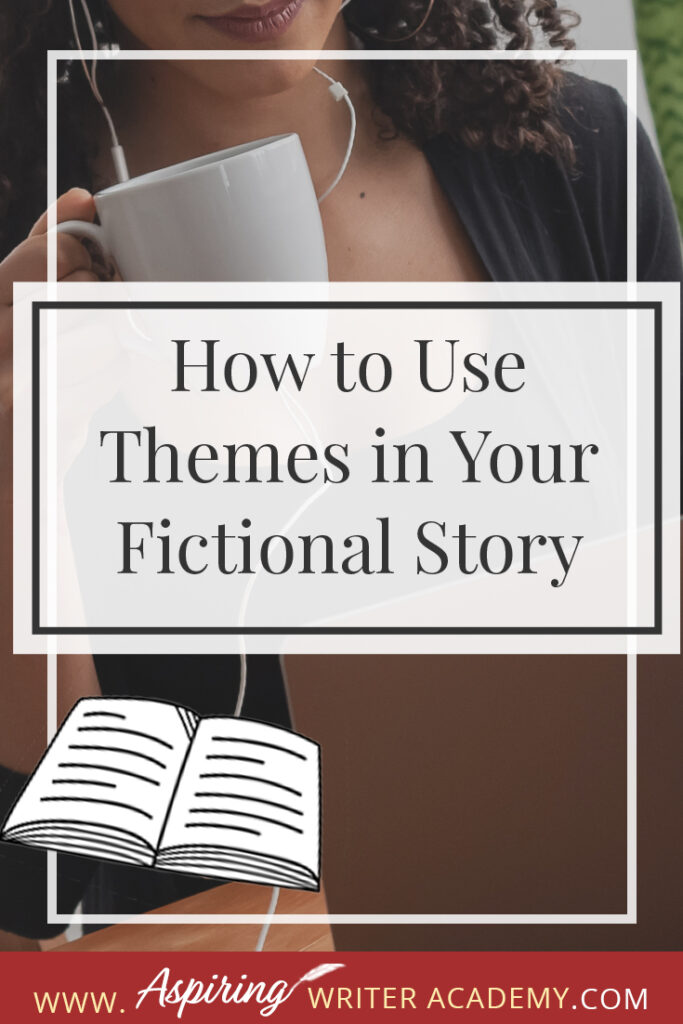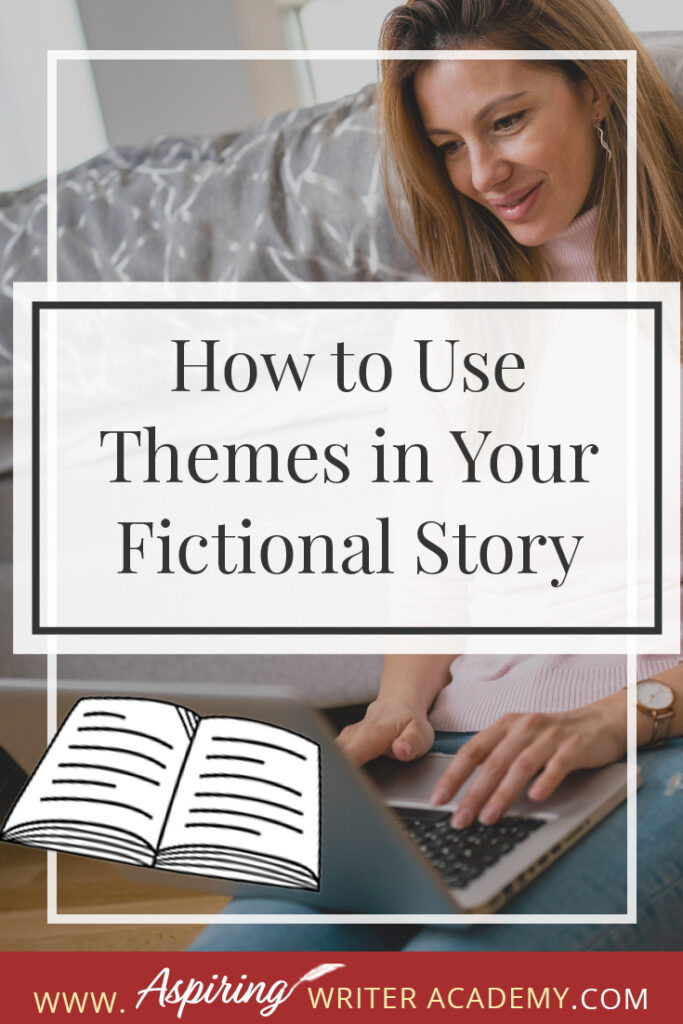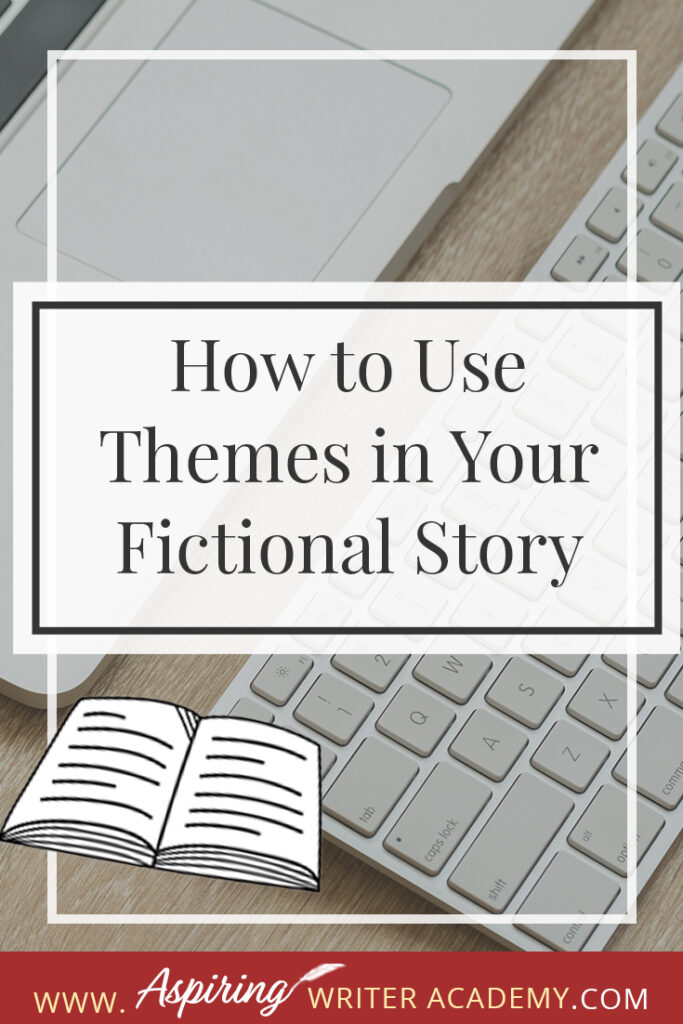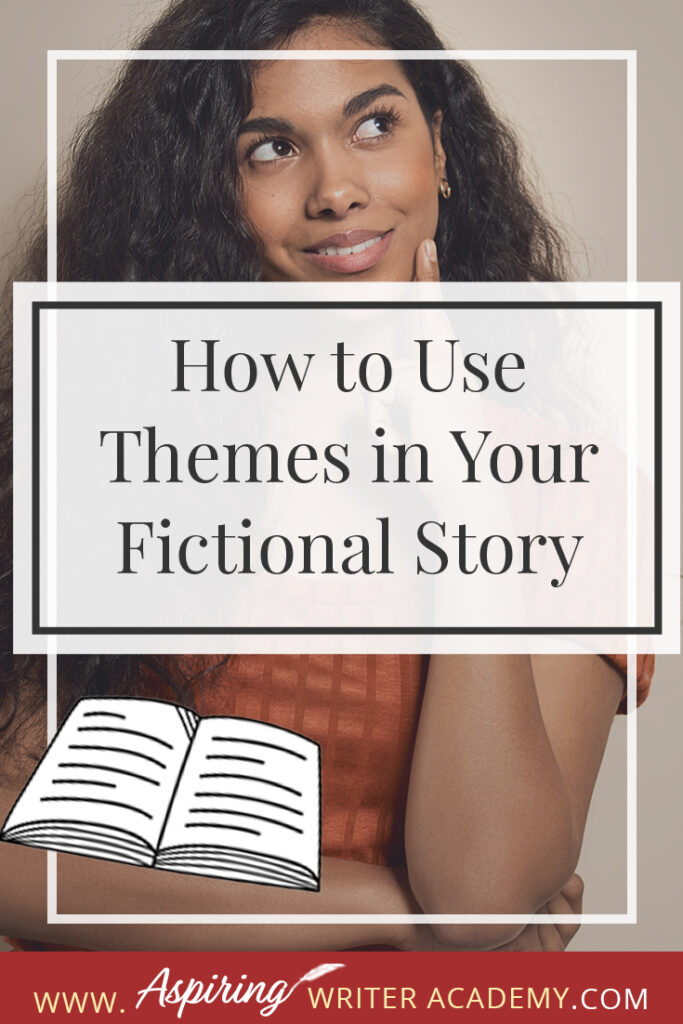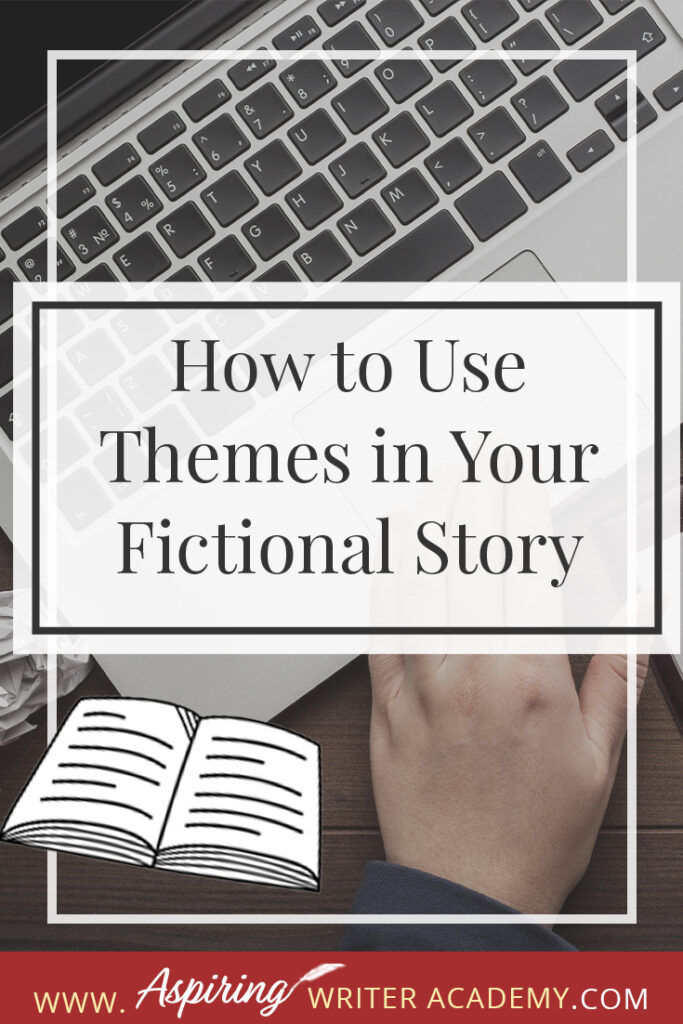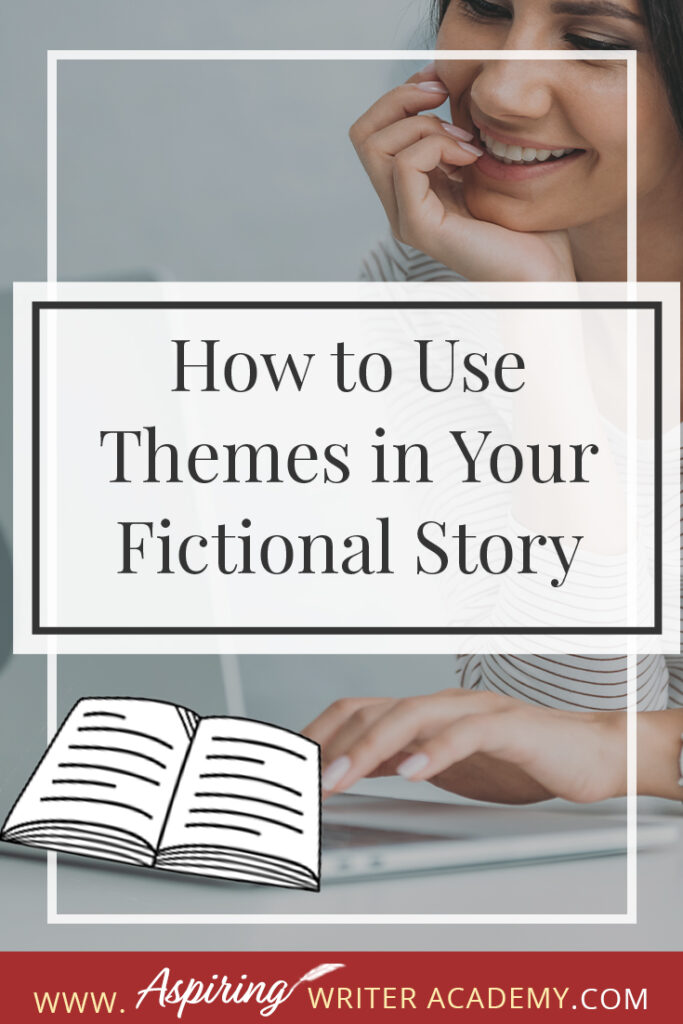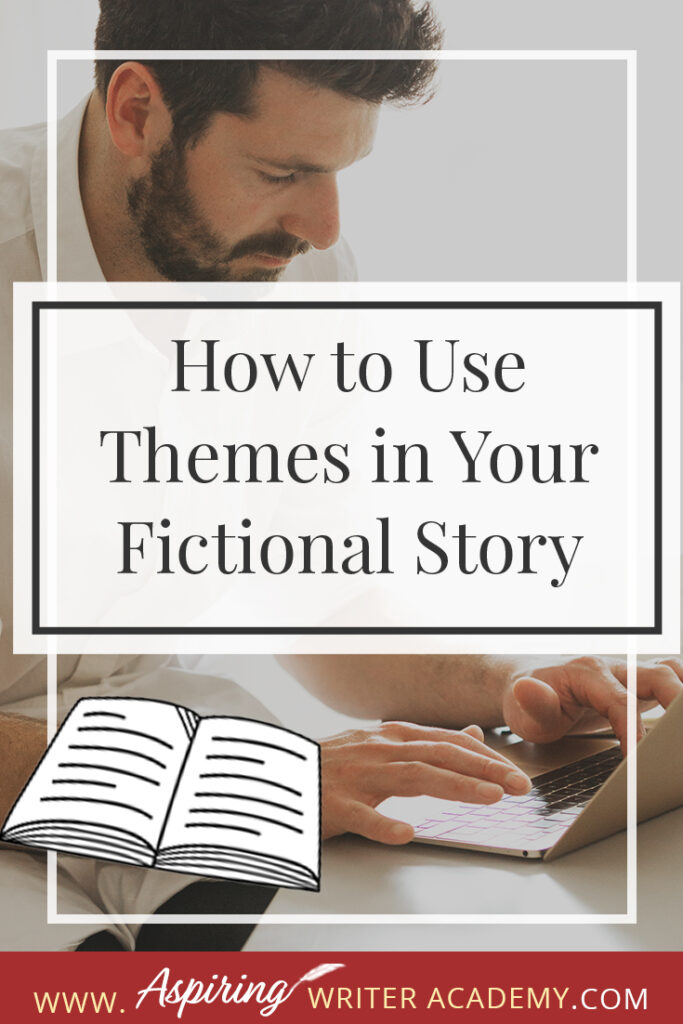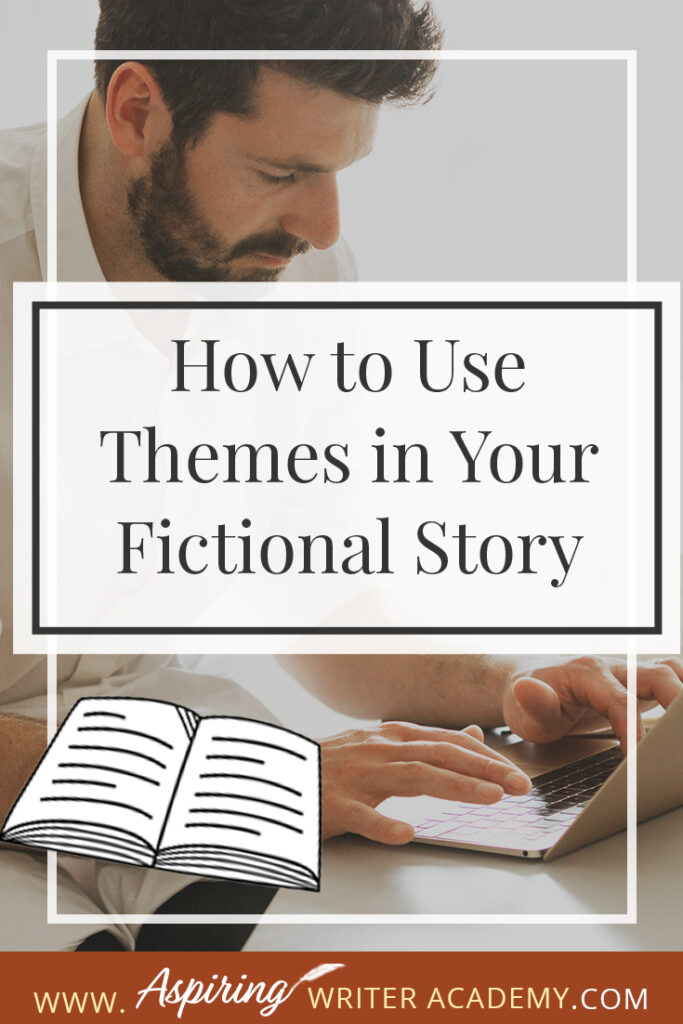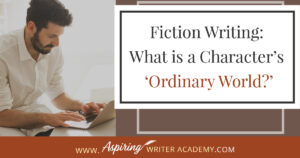How to Use Themes in Your Fictional Story
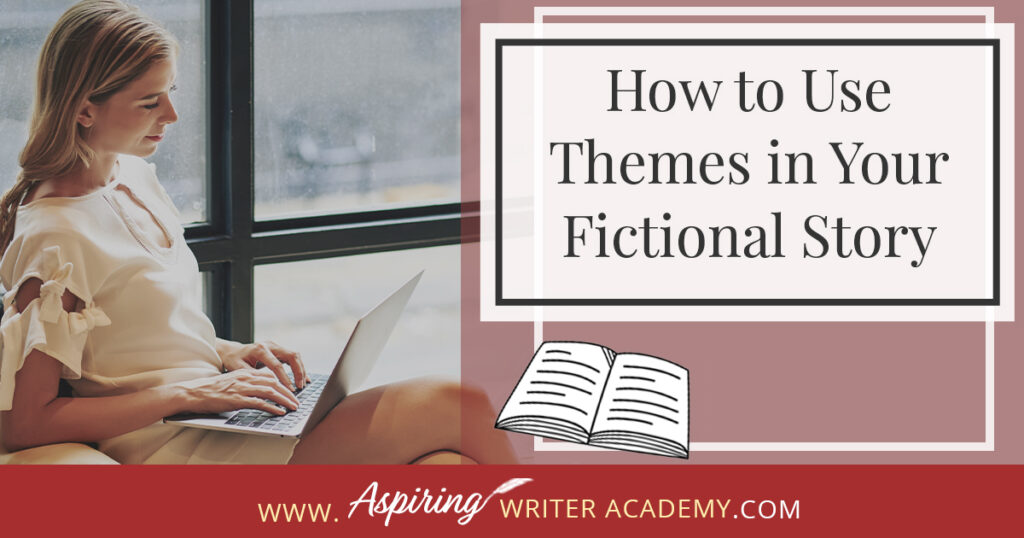
Do you know your story’s theme? Or the difference between a theme and a moral? A theme is the glue that holds your story together and without one, your readers may find themselves scratching their heads wondering what your story is really about.
In our post, How to Use Themes in Your Fictional Story, we give examples of theme, how to weave theme into your story for greater focus, and the right and wrong way to reveal theme at the end of your fictional masterpiece.
In the post below we will discuss:
- What is a Theme?
- Do You Need a Theme?
- How Do You Use Theme in a Story?
- Can a Story Have More Than One Theme?
- How Should Theme be Revealed at the End of a Story?
1) What is a Theme?
Theme is the main point of the story, the underlying message that you would like to share with readers. A central idea that a piece of writing explores.
It is not the plot.
When readers ask, “What is your story about?” they want to know the gist of the storyline. What is the main goal of the protagonist and who or what stands in their way?
To find the theme, ask, “What is your story really about?”
Example: A novel may feature a girl who pretends to be a journalist writing a story on a star athlete to try to win his affection. That is the main plot. But the theme may be Love or Unrequited Love, depending on which way the author wants to go.
At its core, what is your story really about?
A Few Common Themes in literature:
- Forgiveness
- Justice
- Survival
- Beauty
- Courage
- Faith
- Greed
- Corruption
- Abuse of Power
- Freedom
- Aging
- Redemption
- Friendship
- Family
- Identity
- Trust
- Ambition
- Temptation
- Good vs. Evil
- Sacrificial Love
- Perseverance
- Loneliness
- Coming of Age
- Jealousy
- Revenge
- Hope
- Bravery
- Circle of Life
- War
- Heroism
- Loss of Innocence
- Man vs. Nature
- Overcoming Adversity
- Betrayal
- Social Class
- Self-discipline
- Self-reliance
- Prejudice
- Duty
- Honor
- Selfishness
- Loyalty
- Inequality
- Failure / Fame
- Change vs. Tradition
Of course, there are many more.
And many times, a theme (idea) is presented with an opinion which becomes the moral of the story (lesson you want to teach your readers) or ‘thematic statement.’
What do you, as the author, want to say?
That true love conquers all? Or that love cannot be found through deception?
What message do you want to leave with your readers after they finish your story?
The theme, moral of the story, and thematic statements should never be stated directly in the story but should be conveyed through character, plot, setting, and the conflict.
Show, don’t tell!
2) Do You Need a Theme?
Some writers may think that their story doesn’t have a theme, but usually a well-told satisfying story will contain themes the author isn’t even aware of. This is because the author’s opinions, values, and beliefs about certain topics are automatically reflected in their stories.
And sometimes readers find their own themes in your story, themes that speak to them that you, the author, never planned. Finding different themes within a particular story is a fun topic for book clubs to discuss. It is surprising what insights come up.
Other writers decide upon a theme before they write. This helps them keep the story focused from beginning to end. The value in knowing your theme before writing is that you can create specific characters and story events to prove the thematic statement or moral of the story is true. Or perhaps prompt the reader to debate if it is true or untrue. An author can present both sides of an issue and let the reader decide.
While it is very helpful for an author to know the story’s theme before starting to write, oftentimes a writer will begin writing only to discover the story’s theme toward midpoint. First get the story down on paper, and the theme can be strengthened later in the revision process.
3) How Do You Use Theme in a Story?
The theme can be conveyed through character. What is your character struggling with? What does he or she hope to achieve? How can this relate to the theme of your fictional novel? What decisions and actions does the character take that can reveal the core message of the story?
In typical underdog stories which feature the theme of perseverance, you may see a down-on-his luck character, who is unfit or seemingly unworthy of achieving his dream try, try, and try again, no matter how high the obstacles are stacked against him, to win, to succeed, and finally do what no one else ever thought was possible!
Theme can also be conveyed through the events of the plot. Other characters may conspire against the persevering underdog to make things harder for him. Other characters can also try to persevere to achieve a goal but fail, raising the stakes for the hero and the entire story. Situations may also arise to show why perseverance is admirable or how it can take a guy down.
The setting can be used to show how hard the character will need to persevere. He may be locked out of his house and forced to sleep outside in the freezing rain. Or perhaps the society in which he lives does not look kindly on an underdog persevering to try to improve his social status or living situation or see someone do what others only dream about.
A story’s conflict may also highlight the theme, causing a character to question if persevering is worth the fight. What can happen to shine a light on this theme? What value does persevering hold for your character (and hopefully your reader as well)? Why should he continue on?
The theme should be woven through the story using each element. Theme can also be conveyed through word choice and literary style and technique. At every turn, during each scene and chapter, consider how you can weave the theme subtly into the story.
During the revision phase of your novel, an author can find which themes they should strengthen. A clear, strong, unifying theme gives your story purpose. It brings meaning to your story and touches the reader in profound ways. A theme also keeps the story focused so it doesn’t go off on meaningless and confusing tangents.
4) Can a Story Have More Than One Theme?
Yes, a story may have more than one theme, but if you do include additional themes, make sure they relate in some way to the core theme of the novel.
Example:
In a story highlighting the importance of family, a character may need to wrestle with their identity or self-image, or placement within the family, before finding a resolution to their family issues.
Or a struggling vocalist may need to overcome their fear of singing in public before he or she finds fame or success.
A story with a theme of success may show the many upsides and downsides of success through different storylines, characters, and sub-characters. Some of these characters may also need to struggle with fear, overcoming obstacles, self-reliance, trusting others, honesty & betrayal, greed, family, and friendships.
In a war-themed story, different characters and subplots may also display themes of bravery, sacrifice, honor, loyalty, and courage.
Many popular films featuring numerous Hollywood stars acting out different subplots use a unifying theme like love to tie all the storylines together. Each subplot shows a different type of love and the characters each have sub-theme issues they need to work out before love can be found.
5) How should theme be revealed at the end of a story?
Show, don’t tell! Show what the characters have learned by what they now say and do at the end of your story. How are they different than they were at the beginning of the story? What can they now do that they couldn’t do before? The theme should be shown through their actions.
Never have a character state the moral of the story or their lesson learned (referred to as a ‘thematic statement’ in dialogue at the end of your story.
The reader should be able to grasp the intended theme through the story itself. Theme is revealed through the character’s thoughts, decisions, actions, and through the setting, events of the plot, and the character’s reactions to the conflicts that spring up.
The reader should not need to be told what the theme is.
I recently viewed a holiday movie that left me feeling infuriated. The storyline was all over the place (lack of focus) with unrelated themes and subplots that had nothing to do with one another.
Then at the end of the movie, during the big climax that resolves the entire story, a sub-character announces to a crowd, “Believe in (X) because (X) believes in you!”
I was infuriated because the story did not do its job in proving that this thematic statement was true and furthermore—it certainly did not need to be stated!
It appears the scriptwriter took one idea and then another idea and another to string together a plot. But they didn’t create a cohesive plot. Even the sub-characters had a storyline completely different and unrelated to the main plot. Each storyline suggested different themes, but the author never fully fleshed out any of them. Thus, the storyline was an unbelievable tangled mess.
You do not want a big eyeroll from your readers, or they will never pick up another book written by you again.
Your job as a storyteller is to prove the theme is true. Or present debatable pros and cons to let the reader decide if it is true. Either way, you should present a storyline that gives the reader believable closure at the end of the story.
How will you SHOW the needed actions steps to prove the theme is true? Pretend you are a lawyer presenting a case—what facts can you present? What scenes will you create to move the character (and the reader) to believe the facts or opinions you present? What situations will you place your characters in to change their perspective or beliefs? How can you move the character to a setting that will help instigate their change in beliefs?
Also, your characters should grow or change their perspectives over the course of the entire book in tiny shifts or increments, not all at once in one moment at the end. Otherwise, the change—and the story—is completely unbelievable.
Do the events in your story create believable character growth or change within your characters? Could the situations your characters face really trigger a change in perspective? Or is it weak and contrived?
Your current book sells the next book. If you do not prove your theme satisfactorily, or if you throw a blatant thematic line in at the end… Instead of a next sale, you will get a disgusted eyeroll from readers.
You need to leave the reader in a good mood, satisfied that reading your book was worth their time. You want them to feel happy and eager to buy more books from you. A satisfied customer will give you repeat business. Don’t be a sloppy salesman – close the deal (and end the book) the right way so your readers will be eager to come back for more.
What do you want to say to your readers?
Does your story support that message in a believable way?
Give your readers an ending that proves the core theme of your novel and makes them smile.
Make them believe dreams can come true.
That true love does exist.
The early bird is the one who gets the worm.
That crime doesn’t pay.
Slow and steady wins the race.
There is still good in the world.
We hope you have enjoyed How to Use Themes in Your Fictional Story and that you have gained some valuable tips to weave a meaningful message into your novel that will resonate with readers long after they finish the last page.
If you have any questions or would like to leave a comment below, we would love to hear from you!
If you like more help developing your story, you may wish to download our Free Brainstorming Your Story Idea Worksheet
Do you find it difficult to create compelling antagonists and villains for your stories? Do your villains feel cartoonish and unbelievable? Do they lack motivation or a specific game plan? Discover the secrets to crafting villains that will stick with your readers long after they finish your story, with our How to Create Antagonists & Villains Workbook.
This 32-page instructional workbook is packed with valuable fill-in-the-blank templates and practical advice to help you create memorable and effective antagonists and villains. Whether you're a seasoned writer or just starting out, this workbook will take your writing to the next level.
Our Goal for Aspiring Writer Academy is to help people learn how to write quality fiction, teach them to publish and promote their work, and to give them the necessary tools to pursue a writing career.

ENTER YOUR EMAIL BELOW
TO GET YOUR FREE
"Brainstorming Your Story Idea Worksheet"
7 easy fill-in-the-blank pages,
+ 2 bonus pages filled with additional story examples.
A valuable tool to develop story plots again and again.
Other Blog Posts You May Like
Fiction Writing: What is a Pinch Point?
7 Tips for Writing a Story Synopsis
Fiction Writing: What is the ‘Black Moment?’
Fiction Writing: What is the ‘Man in the Mirror Moment?’
Fiction Writing: What is a Plot Hole?
How to Write Act III and Finish Your Fictional Story in 5 Steps
Structuring Act II (Part 2) for Maximum Impact: How to Keep Readers Engaged
Structuring Act II (Part 1) for Maximum Impact: How to Keep Readers Engaged
How to Use Setting to Intensify Your Fictional Scenes
How to Manipulate Pacing to Increase the Intensity of Your Scenes in a Fictional Novel
How to Brainstorm a New Novel Using Goal, Motivation, and Conflict
Fiction Writing: How to Plot a Story where the Antagonist is an ‘Invisible Foe’
Fiction Writing: Create a Storyboard to Map Out Your Scenes
3 Ways to Avoid Writing ‘Episodic’ Scenes in Fiction
How to Write Act I: Opening Scenes for Your Fictional Story
Brainstorming Fiction: What to Do When Your Story Gets “Stuck”
How to Plot Your Fictional Novel (with Free Template Included)
5 Questions to Create Believable Villains
Why Your Characters Need Story-Worthy Goals
How to Captivate Your Readers with Scene-Ending Hooks
Scene & Sequel: The Secret to Plotting an Epic Novel (Part 2)

is a multi-published author, speaker, and writing coach. She writes sweet contemporary, inspirational, and historical romance and loves teaching aspiring writers how to write quality fiction. Read her inspiring story of how she published her first book and launched a successful writing career.


